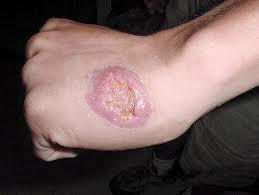In the trenchesProtecting U.S. troops against sand flies
Sand flies are vectors of Leishmania parasites that cause leishmaniasis, a devastating disease for which there is no vaccine or medication; people who are bitten by infected sand flies do not know whether they have the disease until it becomes apparent three or four months later; U.S. Department of Agriculture (USDA) scientists are helping deployed American troops protect themselves against sand flies, which are major pests in Afghanistan, Africa, and the Middle East

Leishimaniasis, caused by sand fly bites // Source: usda.gov
U.S. Department of Agriculture (USDA) scientists are helping deployed American troops protect themselves against sand flies, which are major pests in Afghanistan, Africa, and the Middle East.
Sand flies are vectors of Leishmania parasites that cause leishmaniasis, a devastating disease for which there is no vaccine or medication. People who are bitten by infected sand flies do not know whether they have the disease until it becomes apparent three or four months later. Symptoms include permanent skin disfigurement and sometimes severe organ damage.
A USDA release reports that at the Agricultural Research Service (ARS) Knipling-Bushland U.S. Livestock Insects Research Laboratory in Kerrville, Texas, entomologists Andrew Li and Adalberto Pérez de León, along with their colleagues, are studying different methods to kill sand flies. Part of the research is funded by a USDA initiative called the Deployed War-Fighter Protection Research Program, designed to find methods to help protect military personnel against disease-causing insects.
The researchers are screening insecticides to find out which ones are more effective and useful to military personnel and other people affected by this pest. Li is also studying sand fly resistance to pesticides, and is developing a test for detecting the mutations responsible for resistance.
To evaluate new insecticides and repellents, researchers started a sand fly colony, which will also enable them to develop formulations and design diagnostic tools that can rapidly detect sand fly resistance to chemicals. This research is especially crucial for deployed military personnel.
It was reported that in one incident, troops in Iraq were being bitten between 100 and 1,000 times per night by sand flies.
Finding solutions to control sand flies is also a priority of scientists at the ARS European Biological Control Laboratory in Thessaloniki, Greece, where they’re taking a close look at sand fly populations that transmit leishmaniasis in their country. Results from this research could also help scientists initiate better strategies and develop new and improved tools to control sand flies.
ARS is USDA’s principal intramural scientific research agency.
— Read more in “DWFP: A Battle Plan To Protect U.S. Troops From Harmful Insects,” in the November/December 2012 issue of Agricultural Research magazine
